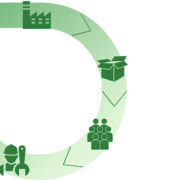GreenBiz | Walmart’s plan to lift a gigaton of carbon from its supply chain

Walmart is doubling down on its climate commitment.
Today, the retail giant announced Project Gigaton, a goal to remove 1 billion metric tons of greenhouse gases from its supply chain by 2030, equivalent to taking more than 211 million passenger vehicles off the road for a year, the company said.
The focus is on Scope 3 emissions — those that are a consequence of business operations but over which it doesn’t have direct control. It is launching an online toolkit for suppliers seeking to better manage energy, agriculture, waste, packaging and deforestation, and to design consumer products with a lower impact — for example, LED light bulbs and apparel that’s washable in cold water.
Every gigaton counts: The entire global carbon emissions from fossil fuel use in 2014 was 9.75 gigatons. Within the next decade, the world must not exceed a carbon budget of 335 gigatons annually in order to limit global warming to 2 degrees Celsius and achieve the Paris Agreement goals.
Managing greenhouse gases in supply chains addresses the gigaton elephant in the room for many companies. According to Trucost, up to 80 percent of an organization’s emissions can be embedded in its supply chain. Walmart already has a goal of reducing Scope 1 emissions — those from sources owned or controlled by the organization — and Scope 2 emissions — from the consumption of purchased energy — by up to 18 percent by 2025. Project Gigaton attacks its remaining — and largest — bucket of emissions.
Walmart already has a goal of reducing Scope 1 and Scope 2 emissions by up to 18 percent by 2025. Project Gigaton attacks its remaining — and largest — bucket of emissions.
“We are initially working with 250 of our top global suppliers, working across multiple product categories like food, personal care products, toys, electronics and apparel,” Laura Phillips, Walmart Stores, Inc. senior vice president for global sustainability, explained to me in advance of the announcement. “Our goal is to have as many suppliers as want to join in. This is a big tent and there is a part for everyone to play.”
The toolkit was intended to be open-source, she said, with a methodology to measure progress and input developed by the partners and NGOs, such as the Environmental Defense Fund (EDF), which has been helping Walmart create sustainability practices since 2005. (See EDF’s separate perspective on Project Gigaton.)
The project also addresses concerns about the transparency of Walmart’s previous sustainability commitments, which often shrouded its supplier evaluation process in an opaque process, even to the suppliers themselves.
The toolkit, Phillips said, is “a digital resource center with the materials, videos and the information we’ve been working on for [over] 10 years in one place. We will be offering that to suppliers so that they can learn what we’ve learned: How do you get started on setting an energy target? How do you work on deforestation? If you’re getting started, we have practical advice, and if you’re experienced, we can help set challenges.”
Read full article here






